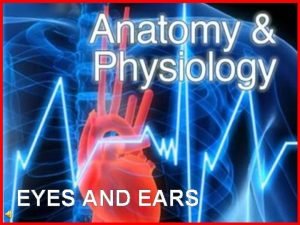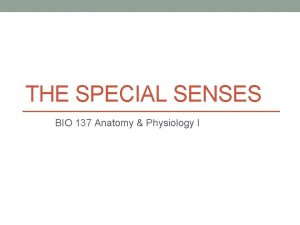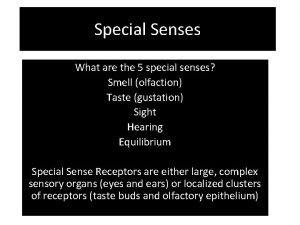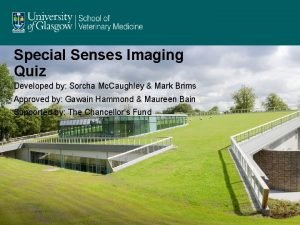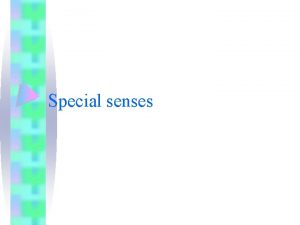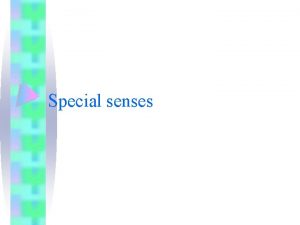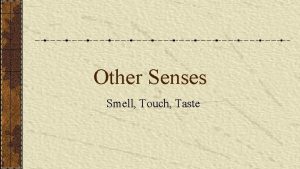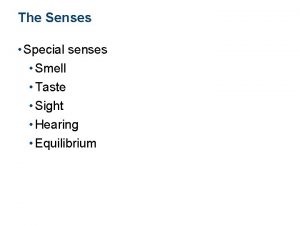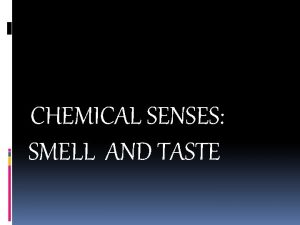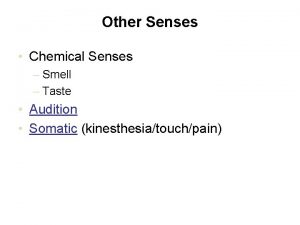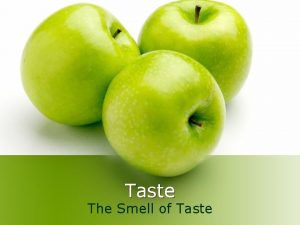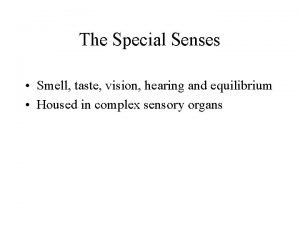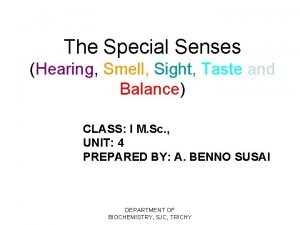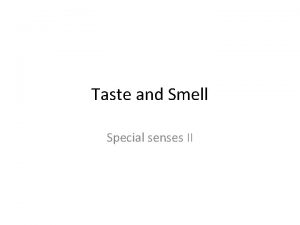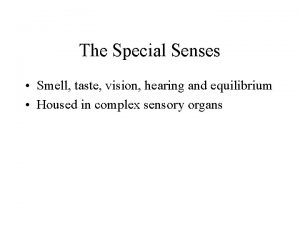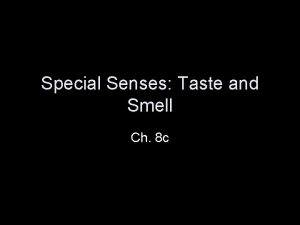The Special Senses Taste and Smell Taste taste





















- Slides: 21

The Special Senses: Taste and Smell

Taste

• taste buds contain chemoreceptors that respond to chemicals in a aqueous solution • most taste buds are on the tongue, a few are on the palate, cheeks, pharynx Taste

• taste buds are located on the sides and tops of papillae • 3 types of papillae and only 2 have taste buds • fungiform (tops) • circumvalate (sides)


• each bud is globular with supporting cells and taste cells (gustatory cells) • taste cells have hairs protruding that are stimulated • the other end of the taste cell stimulates a nerve ending that will carry taste information to the brain

4 Sensations • sensitivity varies according to region of tongue 1. sweet - carbohydrates and amino acids, tip 2. sour - acids, sides 3. bitter - alkaloids, back 4. salty - metal ions, more even

4 Sensations • sensitivity varies according to region of tongue 1. sweet - carbohydrates and amino acids, tip 2. sour - acids, sides 3. bitter - alkaloids, back 4. salty - metal ions, more even

• Most buds respond to several tastes. Taste is 80% smell. Subtle flavors are the result of aromas passing through the nose

• The mouth also contains thermoreceptors and mechanoreceptors that detect temperature and texture ex: “gritty pear” “pasty avocado”

Hot foods trigger pain receptors - chili peppers.

Smell Olfaction

Smell • located in olfactory epithelial lining the roof of the nasal cavity


• Olfactory hairs on the ends of receptor cells are covered with mucous which serves as a solvent for odor molecules.

• we have 15 - 30 kinds of receptors and can distinguish 10’s of 1000’s of smells • chemicals must be volatile (gas) and water soluble in order for us to smell them


• sense of smell fades quickly due to inhibitory influences in central olfactory pathways to the brain - not receptor response.

• Smell triggers emotions and memories because olfactory nerves go directly to limbic system.


 Facts about taste
Facts about taste Distinguish between general senses and special senses.
Distinguish between general senses and special senses. Messiners
Messiners Sight hearing taste smell and touch
Sight hearing taste smell and touch Flow chart of taste and smell
Flow chart of taste and smell Epiglottis taste buds
Epiglottis taste buds Chapter 10 somatic and special senses
Chapter 10 somatic and special senses Chapter 11 labeling exercises
Chapter 11 labeling exercises Anatomy and physiology chapter 8 special senses
Anatomy and physiology chapter 8 special senses Cn v test
Cn v test Ear bone structure
Ear bone structure Somatic and special senses
Somatic and special senses Special senses the eyes and ears
Special senses the eyes and ears The general and special senses chapter 9
The general and special senses chapter 9 Bio 137
Bio 137 What are the special senses
What are the special senses Special senses physiology
Special senses physiology Chapter 17 special senses answer key
Chapter 17 special senses answer key Chapter 8 special senses
Chapter 8 special senses Special senses quiz
Special senses quiz Special senses
Special senses Signal conclusion
Signal conclusion












